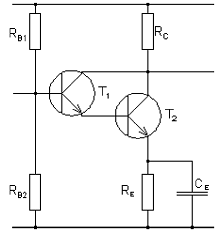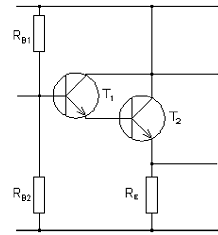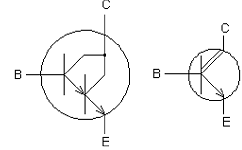Q. Explain by using a circuit diagram, a ‘Darlington Pair'. Mention its advantages?
THE DARLINGTON PAIR : This is a very special way of direct coupling of two transistors. The two are connected with their collectors to the same point. The emitter of the first transistor is connected directly to the base of the next.

A common emitter amplifier with Darlington. The two transistors are interconnected with their collectors, while the emitter of the first transistor feeds into the base of the second. An emitter resistor (RE1) is sometimes used for the first transistor to achieve faster switching.

Common collector amplifier with Darlington. With this amplifier extremely high input resistances and extremely low output resistances can be achieved.
The advantage of the Darlington is the VERY HIGH CURRENT GAIN, which is the product of the current gains of the individual transistors. For ? values up to 20 000 can be achieved.
The Darlington has three terminals, like a normal transistor. In fact it can be considered as ONE transistor. The characteristics or this Darlington transistor can then be expressed in terms of the characteristics of the individual transistors:

Darlington transistors are available in normal transistor housings, e.g. BC517 or BD675.

A Darlington pair in one housing. As for normal transistors, the terminals are called collector, base and emitter.
Different circuit symbols are used for Darlington transistors. A transistor amplifier stage using a Darlington pair is normally considered as ONE amplifier stage, although two transistors are used.